Projects of the Klassik Stiftung Weimar are funded by the European Regional Development Fund (ERDF) and the Free State of Thuringia, represented by the State Chancellery of Thuringia, Department of Culture and the Arts.


What would historical buildings look like today if people had simply continued living in them? What modern-day objects would we find in today’s museum-like settings? A tour of objects and stories.
The “Vampyr” vacuum cleaner stands ready in Anna Amalia’s dressing room in the Wittumspalais, while a Braun electric coffee grinder sits on the shelf in Schiller’s kitchen. What would historical buildings of the Weimar Klassik Stiftung look like today if people had continued living in them? The project “Strange Friends. Modern Guests in Historic Buildings” presents a series of 13 spatial interventions in historic buildings man aged by the Klassik Stiftung Weimar and the Castle and Gardens Foundation. In keeping with the 2023 Theme Year “Living”, selected pieces from the Ludewig Design Collection of the Klassik Stiftung Weimar pay a visit to various historic sites in Weimar, including the Goethe Residence, Kirms-Krakow House, Schiller Residence, Belvedere Castle, Tiefurt Mansion and Wittumspalais. Displaying these modern everyday items in historical settings creates an exciting dynamic that casts these homes in a new and interesting light.
Free entry
plus museum admission
Many of us today find the idea of living in a more beautiful setting very appealing. Of course, such aspirations are often doomed by stereotypical room designs. They are too tidy, too sterile and too impersonal. Living is a practical exercise, and it entails confronting possibilities and combining things, (hi)stories and emotions.
When we redesign our living environment, the items that evoke sentimental feelings are granted permanent residency, regardless of whether they fit in the “mood board”. Other rebellious objects sneak their way into our new homes as loyal, well-functioning companions, though they might not be so pretty to look at. In earlier times, households – like that of the great poet Goethe – often functioned as an incoherent mix of old and new things, collectibles and consumables. Today, over the vast expanse of time, it is difficult to discern how contemporaries regarded such items. Moreover, the exhibitions in the historic residences are often curated, aesthetically arranged interior designs. If the authentic furnishings are no longer avaible, curators carefully select objects from the respective
historical period. In this way, we are presented with an entirely coherent scene, but by no means a moment frozen in time. “Strange Friends – Modern Guests in Historic Buildings” calls these aesthetic, idealised images into question and contemplates the value of the “disruptive” individual piece. The project highlights the discrepancy between the dream and reality of living and invites visitors to rediscover well-known rooms and historical sites.
There are stickers for all 14 stations that can be stuck into a scrapbook. The scrapbook is available for 2 € at the respective museum ticket office.
Wittumspalais, Dining Room
Achille & Pier Giacomo Castiglioni: Brionvega, stereo radio receiver with record player RR 126, 1965 · Josef Hoffmann, Jacob & Joseph Kohn: armchair no. 725/BF, ca. 1902 · Richard Riemerschmid, Dresden Workshops for the Handicrafts, chair, ca. 1902 · Richard Riemerschmid, United Workshops for Art in the Trades, chair for a music room, 1899
The guests seated around this dining room table most certainly discussed the latest trends in London and Paris. The chairs with the stylised rose in the backrest were specifically recommended by the Journal des Luxus und der Moden, the Town & Country magazine of the 18th century. But even the best chairs are destined to fall out of fashion and become worn-out. Perhaps around 1900 someone would have replaced them with furniture produced by the Vienna Workshops or the Dresden Workshops for the Handicrafts, which embodied the new, sheer elegance of the times. People today continue to collabo-rate in so-called “coworking spaces” despite the fact that the dinner music is piped through loudspeakers.
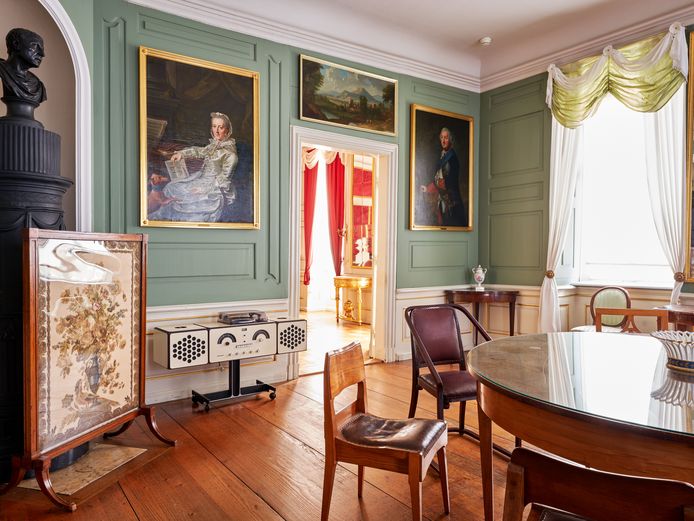

Wittumspalais, Anna Amalia`s room
with Manolo Blahnik Slippers Mafrisa & AEG Vacuum Cleaner Vampyr
The French vaudeville star Edmonde Guy, sporting a silk dress, high-heels and a bob, advertised the Vampyr vacuum cleaner in 1929. The manufacturer promised women that even a housewife could be all lady. Anna Amalia probably had no problems keeping her home clean, but the situation changed in the mid-19th century. Domestic servants started looking for better working conditions and higher wages in the factories. But someone had to remove the crumbs from the carpets. In the United States, the first horse-drawn vacuum cleaner swept the dirt off the street using a long hose that could be inserted through the window. In the 1920s and 1930s, vacuum cleaners became smaller and easier to handle – an elegant addition to a lady’s home.
Wittumspalais, Study room
with portable typewriter Cella S1001 by Robotron and desk lamp by Karl Trabert, Schanzenbach & Co
In politically volatile times, writing on the run could apply to travel writers and fugitives alike. Aside from literary works, many petitions for clemency and requests were written this way. With the arrival of the typewriter, sending a handwritten letter to the authorities would have been unusual. Because the first typewriters were extremely heavy, typewriting was a “sedentary” activity. The first portable typewriters were manufactured in 1910 and have since become the trusted companion of “writing nomads” everywhere. Because they could be easily packed away, these lightweight machines were used as tools for political resistance and could produce several copies at a time.


Schillers Wohnhahus, Kitchen
with coffee mill KMM
Friedrich Schiller liked drinking his coffee with sugar and appreciated its stimulating effect. A coffee roaster would have likely been a standard kitchen appliance in those days as coffee beans were sold green. After roasting, the beans had to be finely ground. Since the beginning of the 18th century, coffee drinkers have used hand-crank coffee mills for this purpose. Schiller would have probably had such a coffee mill in his kitchen. Although coffee mills appeared to go out of style with the arrival of vacuum-packed coffee in the 1960s, they have remained indispensable among.
Schillers Wohnhaus, Daughter`s bedroom
High Children’s Chair (re-edition)
Friedrich Schiller, his wife and three children moved to Weimar from Jena in 1799. His sons Karl and Ernst were six and three at the time, and his daughter Karoline was just three months. His second daughter Emilie was born in 1804. The girls slept in their own bedroom. Back then, children’s furniture was simply furniture in miniature format. It wasn’t until 1866 that the Thonet Co. started manufacturing special children’s chairs and offered a highchair for use at the dinner table. The Dutch De Stijl artist Gerrit Rietveld also devoted himself to this problem. His High Children’s Chair of 1919 looks like it was made with building blocks.


Goethes Wohnhaus, Majolica room
mit "large fruit plate" by El Lissitzky
The Majolica Room was originally Goethe’s and his wife Christiane’s bedroom. Ten years after her death, he converted the room into a collection cabinet for his majolica. With their motifs of a “productive and cheerful life”, the plates offered Goethe and his guests “amusement for the eyes” on long winter nights. Only 100 years later, the early Soviet Union urged artists to create so-called “agitation porcelain” and dishware with abstract suprematist imagery. Artists answered the call and produced everyday items, most of which were exported and became – like the majolica – highly sought-after collector’s items.
Kirms-Krackow-Haus, Salon
with photo album, Smoking and table lighter
The smoking room was reserved for gentlemen only. They would put on their dinner jackets and vanish into the blue haze. Expensive cigars are still a symbol of masculinity and affluence. The architect Ludwig Mies van der Rohe was often photographed enjoying a good cigar while reclining on one of his iconic cantilever chairs. Cigars were stored in a special cabinet called a humidor. The stylish humidor in this room was not designed by Mies van der Rohe, but rather his business partner, the designer Lilly Reich.
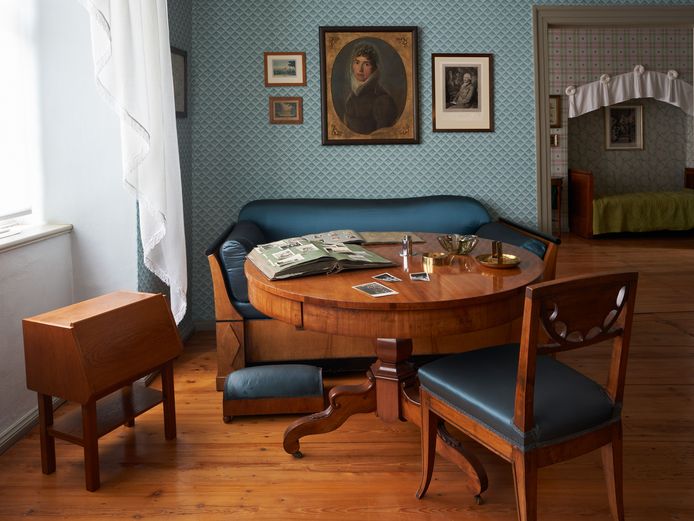
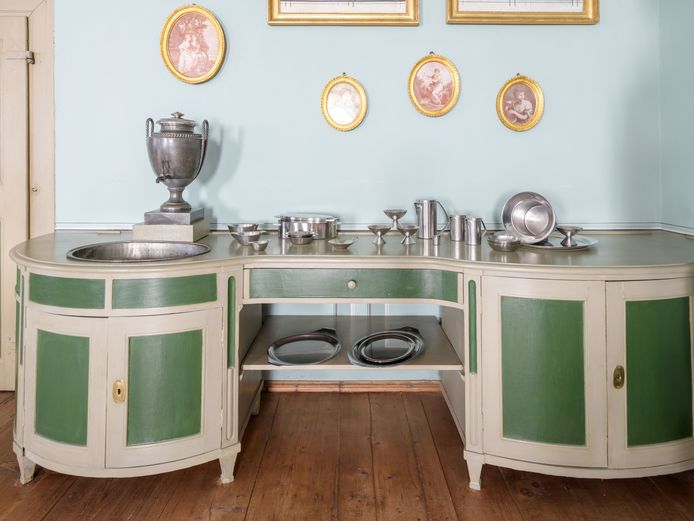
Tiefurt Mansion, Dining room
with restaurant tableware ABS Stainless Steel
Social gatherings at Tiefurt Mansion had a more rustic and casual character. Duchess Anna Amalia served her guests in the dining room which included a large sideboard and a water dispenser – a must-have in any cultivated dining room! The dishes were arranged on the sideboard much like a modern buffet. The fine GDR restaurant tableware by Christa Petroff-Bohne is robust, stackable (i.e. space-saving) and easy to clean. It was designed to be both beautiful and practical for serving staff and guests alike. It would have certainly met the requirements of Anna Amalia’s unconventional lifestyle at Tiefurt Mansion.
Tiefurt Mansion, Fireplace room
with Artificial plant Monstera deliciosa and flower watering can
Indoor gardens became popular around 1800. They literally brought the garden into one’s living quarters. So-called jardinieres with metal rims were developed for this purpose. Two hundred years ago, potted plants – especially palms and ferns – became permanent fixtures in bourgeois homes. The plants were always chosen according to the latest fashion. Many useful items were created for these indoor gardens, such as planters, plinths, tables and watering cans. This elegant flower watering can was designed by Klaus Kunis around 1960. The long spout allowed one to carefully administer water into the pot so as to prevent overflowing.

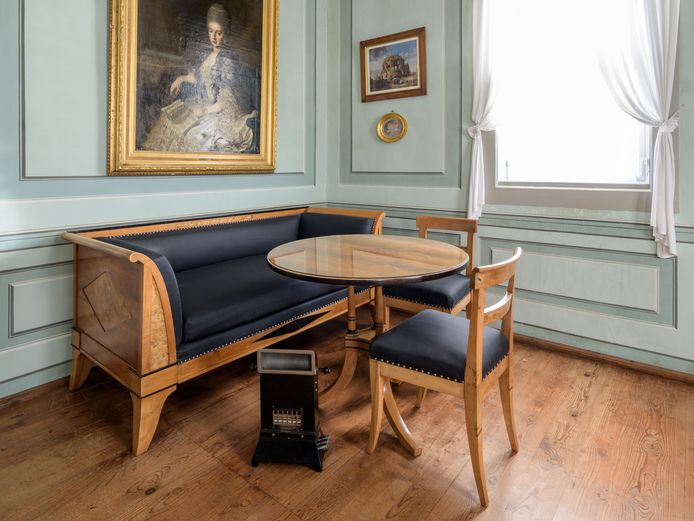
Tiefurt Mansion, Music room
with electric heater Frewa
Duchess Anna Amalia gathered her academie de musique, a group of music lovers like herself, in the music room. During the passionate recitals, the musicians were often distracted by the guests’ chattering teeth. The lack of sufficient heating dampened the enjoyment of all. Drawing on inspiration from her trip to Italy, the Duchess installed a pot of glowing coals on a tripod. A disaster waiting to happen! With the arrival of electricity in private homes, portable electric heaters soon came on the market.
Tiefurt Mansion, bedroom
with hairdryer
Behind every flawless maquillage is always a set of fancy accessories. Inside the dressing table in Anna Amalia’s bedroom, we find numerous helpful utensils in custom-fitted compartments. Ladies’ hairdos were miniature works of art, for which coiffeurs required many hours. Nowadays, either for lack of money or time, modern women rely on their own skills, practical bobs and electric hairdryers. The latter was introduced by AEG in 1900. The first portable device, called the “hot-air shower” weighed a whopping 1.8 kg. Its advertisement claimed it could relieve rheumatism, and not only could it dry hair, but also damp laundry, feather boas and wet dogs.
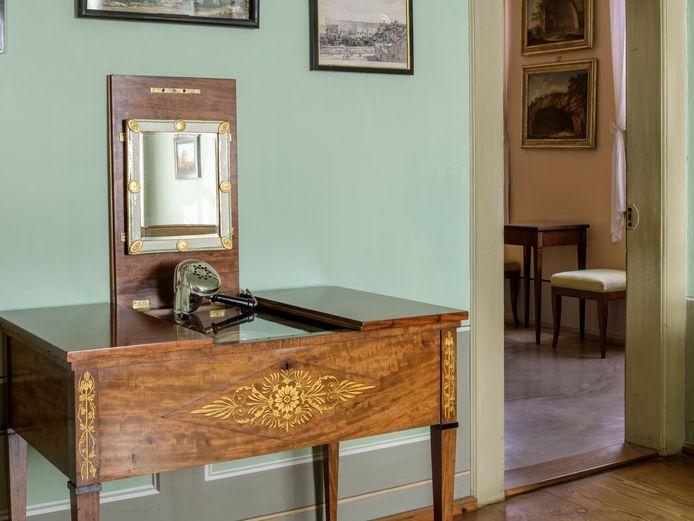
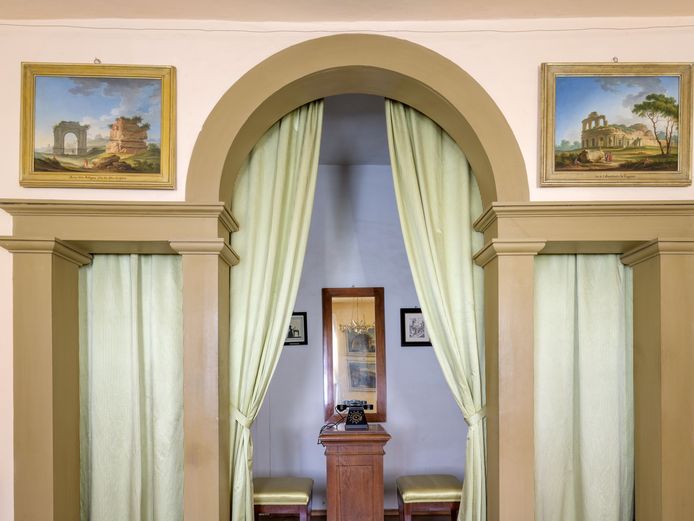
Tiefurt Mansion, Alcove room
with Climax telephone
The Alcove Room was the communication hub of the house. All lines converged in this room. The housemaid slept in the alcove and could be summoned at any hour. The wires passed through multiple rooms and, when tugged, would set bells ringing throughout the house. With the advent of electricity, it was possible to install complex systems using lights or electric buzzers. The invention of the telephone facilitated an efficient, but more anonymous house service. Starting in 1878, the telephone network allowed communication in real time with others outside one’s household.
Tiefurt Mansion, Luise von Göchhausen’s room
with Bauhaus chessboard by Josef Hartwig
Chess was likely not so much a favourite among guests at Tiefurt Mansion as other board games were. After all, chess was considered a gentleman’s game, and that since the 16th century. It wasn’t until the 1860s that women finally conquered the chess board. Vera Menchik achieved enormous success in the chess world in the 1920s, literally outmanoeuv-ring her male colleagues. One of the most successful women chess masters today is the Iranian Sarasadat Khademalsharieh. With the move shown here, she won the rapid chess world championship in 2022 after 33 moves. She played without a hijab.
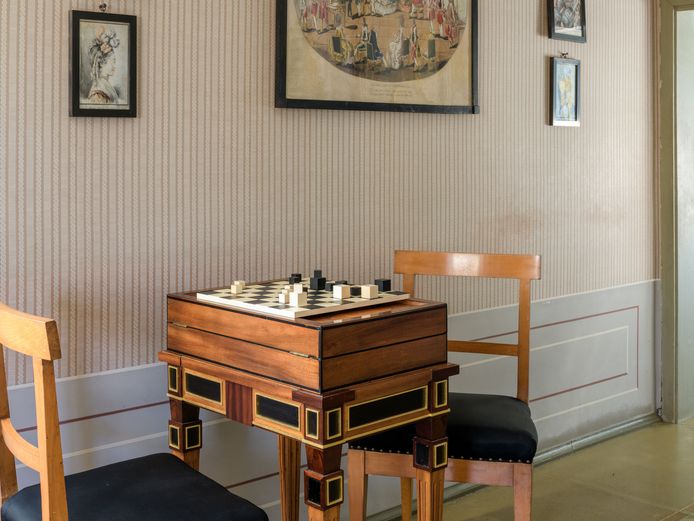

Belvedere Castle, Grey Salon
with chairs and coffee table by Charles Eames, tea service by Marguerite Friedlaender-Wildenhain, tea trolley by Alvar Aalto, rocking chair by Cesare Leonardi and TV set by Marco Zanuso & Richard Sapper
“Sunny loft with historical parquet flooring, ceiling mural and an unobstructed view of Weimar, situated on palatial grounds”. This is how one might advertise the Grey Salon at Belvedere Castle in the property listings in the newspaper. The builder, Duke Ernst August I, possessed excellent taste. Nowadays various living functions are visibly integrated in large rooms. One enjoys tea with company, while another relaxes in an Italian designer rocking chair, awash in the flicker of a television set. Here, purism is the mark of true luxury.
Organizers